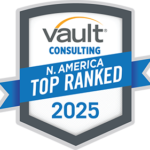
Article
Beyond Rivalry: Leveraging Competitive Intelligence for Strategic Advantage
Jordan Shapiro — October 16, 2025
Too many organizations operate with an incomplete view of their competitive landscape. Recent Level5 research showed that over 70% of business leaders acknowledge they haven't fully integrated competitive assessments into strategic planning. What's even more surprising: only 7% cite competitive intelligence as a priority when developing their strategies.[1] The result? High-stakes strategic decisions are made without complete market context, leading to weak differentiation and vulnerability to better-informed rivals.
Widening Your Aperture with the 3Comp Framework
Effective competitive intelligence requires expanding your view across three categories:
Competitors
Your direct market rivals
- Why it matters: Understanding the full competitive landscape – from current offerings to future threats – helps to identify both immediate differentiation opportunities and longer-term strategic positioning needs.
- Key questions: What value are they delivering to shared customers that we’re not? Where are they investing that we’re not? What capabilities are they building?
Comparators
Organizations customers use as reference points, often from different sectors
- Why it matters: Customer expectations are shaped by best-in-class experiences across industries, not just in your sector. Understanding these benchmarks helps leaders anticipate shifting standards and identify where they need to elevate performance.
- Key questions: Who is setting the performance standards our customers expect from us? What experiences are shaping customer expectations? Where are the performance gaps?
Complementors
Businesses with overlapping characteristics or customer bases
- Why it matters: Strategic partnerships can unlock new value creation, expand market reach, and strengthen competitive positioning – but they require understanding both alignment opportunities and potential competitive risks.
- Key questions: Where could strategic alignment create mutual value neither could achieve alone? Who shares our customer base but offers different value? What partnerships could strengthen our market position?
How to Get There
The best organizations move beyond data collection, treating competitive intelligence as context for strategic decision-making. They understand the landscape well enough to make intentional choices about when to lead, when to follow, and when to chart a different path entirely. This means having clarity not just on what competitors are doing but understanding why those moves matter for your own positioning and where the white space opportunities exist. Building effective competitive intelligence requires moving beyond periodic competitor reports to embedding market awareness into strategic decisions.
- Integrate all three lenses into strategic planning cycles – Don’t just scan direct competitors during annual planning; systematically map who customers compare you to and identify potential complementor relationships
- Use customer research to reveal expectation gaps – Understand where customer expectations are being shaped across industries and how you’re positioned relative to those benchmarks
- Focus on strategic questions, not endless data collection – Use targeted questions across all three categories to guide intelligence gathering rather than collecting information without clear purpose
- Create systematic market monitoring across functions – Empower teams throughout the organization to observe and report on competitive moves, customer feedback, market shifts, and partnership opportunities in real time
- Establish regular forums for competitive insights – Build structured discussions where cross-functional teams can surface observations and assess what competitive intelligence means for strategic decisions
The goal is making competitive awareness a capability, not just an annual exercise.
The Bottom Line
Good competitive intelligence doesn’t mean obsessing over what everyone else is doing. It means understanding the market well enough to chart your own path. When you get it right, you end up with a strategy that is both grounded in reality and clear about what makes you different.
[1] Level5 Strategy Omnibus Data
At Level5 Strategy, an award-winning leading boutique management consulting firm trusted by leading organizations, we help leaders turn market insight into strategic advantage. Whether you’re exploring our unique approach to embedding competitive intelligence into decision-making or uncovering opportunities for growth. For more expert perspectives on strategic planning, explore our latest thinking or connect with our team.




